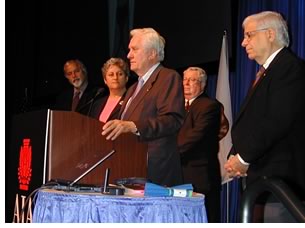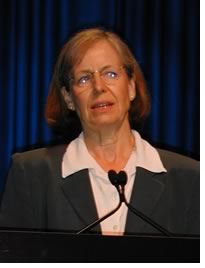

Neuroscience Research Gains Support From Legacy Project, Latrobe Grant
 A
two-decade-old research partnership focused on the emerging understanding
of the relationship between the brain and the built environment has culminated
in the Academy of Neuroscience for Architecture, the Legacy Project of
the 2003 AIA National Convention in San Diego. In turn, College of Fellows
Chancellor Sylvester Damianos, FAIA, announced during the May 9 general
session of the AIA national convention that the Academy of Neuroscience
for Architecture will receive the Latrobe Fellowship, a $100,000 grant
to pursue research to answer questions about how the human brain perceives
architecture.
A
two-decade-old research partnership focused on the emerging understanding
of the relationship between the brain and the built environment has culminated
in the Academy of Neuroscience for Architecture, the Legacy Project of
the 2003 AIA National Convention in San Diego. In turn, College of Fellows
Chancellor Sylvester Damianos, FAIA, announced during the May 9 general
session of the AIA national convention that the Academy of Neuroscience
for Architecture will receive the Latrobe Fellowship, a $100,000 grant
to pursue research to answer questions about how the human brain perceives
architecture.
 The
Legacy Project, a new formal collaboration of architects and scientists
to study how the human brain perceives and responds to cues from architecture,
that has been in the works for 18 months, marks a “new beginning
bursting with potential,” said Alison M. Whitelaw, San Diego Architectural
Foundation president, who announced the legacy project at the same session.
The
Legacy Project, a new formal collaboration of architects and scientists
to study how the human brain perceives and responds to cues from architecture,
that has been in the works for 18 months, marks a “new beginning
bursting with potential,” said Alison M. Whitelaw, San Diego Architectural
Foundation president, who announced the legacy project at the same session.
The foundation, with the support of the AIA national component and its leadership, established the not-for-profit academy to collect and disseminate hard scientific data on links that, Whitelaw said, will validate existing hypotheses or provide new findings to bridge neuroscience research and architecture studies. The academy’s San Diego location will take advantage of the area’s nexus of neuroscience experts and activities.
An advisory committee of architects and neuroscientists is developing short- and long-term planning goals and, with an organizing committee primarily composed of San Diego architects, is working out the academy’s management, communication, and business matters. Among them are plans to identify potential funding sources, establish workshops, line up projects in architecture education, and develop videos and an Internet site.
Neuroscience research receives $100,000
from College of Fellows
The winning proposal, “Fundamental Neuroscience Research and Development
for Architecture,” a project presented by John P. Eberhard, FAIA,
seeks to define and study the links between neuroscience and the built
environment that are the focus of the academy.
 The
grant, named for architect Benjamin Henry Latrobe, is awarded biennially
by the AIA College of Fellows for research leading to significant advances
in the architecture profession. The award was doubled from $50,000 to
$100,000 this year. The jury, which Damianos stressed was not affiliated
with the legacy project organizers, included Chair Cynthia Weese, FAIA,
dean of the Washington University School of Architecture; Thomas W. Ventulett,
FAIA, principal of AIA Firm Award Winner TVS & Associates; Robert
Geddes, FAIA, Topaz Medallion winner; Robert A. Odermatt, FAIA, former
College of Fellows chancellor and founder of the Latrobe Fellowship program;
and Sylvester Damianos, FAIA, 2003 chancellor of the College of Fellows.
The jury complimented all the grant proposals for promoting significant
research that strengthens the profession.
The
grant, named for architect Benjamin Henry Latrobe, is awarded biennially
by the AIA College of Fellows for research leading to significant advances
in the architecture profession. The award was doubled from $50,000 to
$100,000 this year. The jury, which Damianos stressed was not affiliated
with the legacy project organizers, included Chair Cynthia Weese, FAIA,
dean of the Washington University School of Architecture; Thomas W. Ventulett,
FAIA, principal of AIA Firm Award Winner TVS & Associates; Robert
Geddes, FAIA, Topaz Medallion winner; Robert A. Odermatt, FAIA, former
College of Fellows chancellor and founder of the Latrobe Fellowship program;
and Sylvester Damianos, FAIA, 2003 chancellor of the College of Fellows.
The jury complimented all the grant proposals for promoting significant
research that strengthens the profession.
“We enormously appreciate the support of the College of Fellows,” said Eberhard. “Over the next two years, we expect to expand considerably the knowledge base that allows us to practice architecture.”
Copyright 2003 The American Institute of Architects.
All rights reserved. Home Page ![]()
![]()
